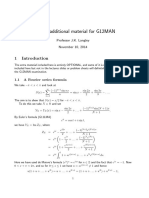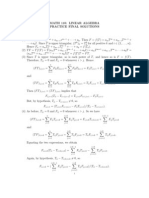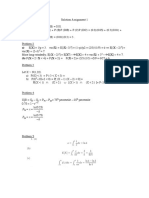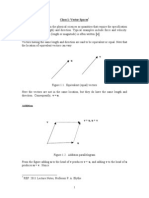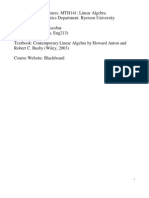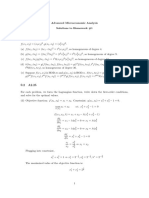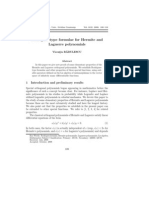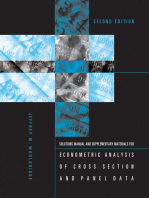Householder Matrices
Householder Matrices
Uploaded by
m-rasheedCopyright:
Available Formats
Householder Matrices
Householder Matrices
Uploaded by
m-rasheedOriginal Description:
Copyright
Available Formats
Share this document
Did you find this document useful?
Is this content inappropriate?
Copyright:
Available Formats
Householder Matrices
Householder Matrices
Uploaded by
m-rasheedCopyright:
Available Formats
Householder Matrices
DEFINITION. A linear transformation P of
n
is said to be a projection if
P
2
= P* = P.
PROPOSITION. If P is a projection, then 1 - P is a projection.
PROOF. We have that
(1 - P)* = 1 - P
and
(1 - P)(1 - P) = 1 - (1)P - P(1) + PP = 1 - P - P + P = 1 - P.
Thus, the linear transformation 1 - P is a projection. Q.E.D.
EXAMPLE. Let a be a unit vector in
n
. Let a!a denote the linear transformation
a!a(x) = <x, a>a.
Then a!a is a projection. This was demonstrated in Homework 8. The matrix of this linear transformation is A =
aa* since
Ax = aa*x = (a*x) a = <x. a> a.
EXAMPLE. More generally, let a and b be vectors in
n
. Let a!b denote the linear transformation
a!b(x) = <x, b>a.
The matrix of a!b is given by ab*.
DEFINITION. Let a be a unit vector in
n
. The linear transformations of the type U
a
given by
U
a
(x) = x - 2<x, a>a
is called a Householder transformations.
PROPOSITION. Let a be a unit vector in
n
. Then the Householder transformation U
a
is a selfadjoint unitary
transformation.
PROOF. The Householder transformation U
a
can be expressed as
U
a
= (1 - P
a
) - P
a
.
where P
a
= P is the projection
P(x) = <x, a>a.
So we have that
U
a
* = ((1 - P) - P)*
= (1 - P)* - P*
= (1 - P) - P = U
a
and
U
a
*U
a
= U
a
U
a
= ((1 - P) - P)((1 - P) - P)
= (1 - P)
2
-P(1 - P) - (1 - P)P + P
2
= (1 - P) - (P - P
2
) - (P - P
2
) + P
= (1 - P) - (P - P) - (P - P) + P
= 1 - P + P = 1.
So we have that U
a
is a selfadjoint unitary. Q.E.D.
Householder Matrices page 1
PROPOSITION. Let w = (0, , 0, cos ", 0, , 0, sin ", 0, , 0). Then
A Householder transformation has a simple geometric description.
PROPOSITION. Let a be a unit vector. Then U
a
(a) = - a and U
a
(x) = x for every x perpendicular to a. Here x is
perpendicular to a if <x, a> = 0.
PROOF. We have that
U
a
(a) = a - 2<a, a>a = a - 2a = -a
and
U
a
(x) = x - <2x, a>a = x
if x is perpendicular to a. Q.E.D.
The diagram for the Householder transformation is the following:
The geometry of the Householder transformation is useful in deriving formulae for moving vectors aroud via a
Householder transformation.
PROPOSITION. Let x and y be vectors of the same length in
n
with x # y. Then Householder transformation U
w
with
w =
x - y
||x - y||
takes x onto y.
REMARK. If x = y in the preceding formula, then the Householder transformation U
0
= 1 maps x onto y = x.
PROOF. We have that v = x + y is perpendicular to w since
<w, v> =
x - y
||x - y||
, x + y =
1
||x - y||
<x, x> + <x, y> - <y, x> -<y, y> = 0.
Here we used the fact that
<x, x> = <y, y>
from the hypothesis on the length and the fact that
<x, y> = <y, x>
since x and y are in $
n
. So we have that
U
w
(x + y) = x + y.
Thus, we get that
Householder Matrices page 2
U
w
(x) = U
w
x - y
2
+
x + y
2
=
1
2
U
w
(x - y) +
1
2
U
w
(x + y) = -
1
2
(x - y) +
1
2
(x + y) = y.
Q.E.D.
A Householder matrix can be used to drive a matrix to so-called Hessenberg form.
DEFINITION. An n " n matrix A = (a
i j
) is said to be in (upper) Hessenberg form if a
i j
= 0 if i > j + 1.
The definition means that A is in Hessenberg from if everything below the subdiagonal of a matrix is 0. The
subdiagonal is the diagonal from the upper left hand corner to the lower right hand corner that lies immediately
below the main diagonal.
We now show that there is a Householder transformation that will "zero-out" the lower entries of a vector.
LEMMA (Zeroing Out Lemma). Let a = (a
1
, , a
n
)
T
be a vector in !
n
. Then there is a Householder matrix
U
w
such that
U
w
a = ||a|| e
1
(respectively, U
w
a = - ||a||e
1
).
PROOF. First we see that the vector w% = a - ||a|| e
1
is perpendicular to a + ||a||e
1
since
<a - ||a||e
1
, a + ||a||e
1
> = ||a||
2
- ||a|| <a, e
1
> + ||a|| < e
1
, a> - ||a||
2
<e
1
, e
1
> = 0
Setting
w = w%/||w%||,
if w% # 0, we get that
U
w
(a) =
1
2
(U
w
(a - ||a||e
1
) +
1
2
U
w
(a + ||a||e
1
)) = -
1
2
(a - ||a||e
1
) +
1
2
(a + ||a||e
1
) = ||a||e
1
.
If w% = 0, then we take U equal to the identity.
A similar proof holds for the second case. Q.E.D.
REMARK. A same Lemma holds for complex vectors. We show that there is a complex number & of modulus 1
and a unit vector w with the propery
U
w
a = &||a||e
1
.
Here we assume that there is some need for the zeroing out, i.e., that
|a
2
| + + |a
n
| > 0.
For every complex number & of modulus 1, the vector
a - &||a||e
1
= (a
1
- &||a||, a
2
, , a
n
)
is nonzero. We shall give the proper choice of & presently. We form the Householder transform U
w
where w is the
vector
w =
a - &||a||e
1
|| a - &||a||e
1
||
.
By the geometry of the Householder matrix, we get
U
w
(a - & ||a||e
1
) = - (a - & ||a||e
1
)
and
U
w
(a + &||a||e
1
) = a + &||a||e
1
since
Householder Matrices page 3
<a -&||a||e
1
, a + &||a||e
1
> = ||a||
2
- &<||a||e
1
, a > + &<a, ||a||e
1
> - |&|
2
||a||
2
.
Now we see that the proper choice of & is the complex number of modulus 1 with the property
&<||a||e
1
, a > ' $.
This is the number
& =
<||a||e
1
, a >
<||a||e
1
, a >
if &<||a||e
1
, a >is nonzero or 1 if &<||a||e
1
, a > = 0. Then we have that
&<||a||e
1
, a > = &<||a||e
1
, a > # &<a, ||a||e
1
>
so that
- &<||a||e
1
, a > + &<a, ||a||e
1
> = 0.
Now we can compute U
w
a as
U
w
(a) =
1
2
(U
w
(a - &||a||e
1
) +
1
2
U
w
(a + &||a||e
1
)) = -
1
2
(a - &||a||e
1
) +
1
2
(a + &||a||e
1
) = &||a||e
1
.
To prove the second part we use the vector a + &||a||e
1
THEOREM. Let A be an n " n complex matrix. There are Householder matrices U
1
, , U
n -1
such that
U
n -1
U
2
U
1
A
is upper triangular.
PROOF. We do this in the ususal way by a deflation process. We examine the first column a
1
of A and find a
Householder matrix U
1
such that
U
1
a
1
=
(
0
0
.
Here U
1
is found as in the previous part so that
U
1
a
1
= ||a||e
1
.
Then we have that
U
1
A = [U
1
a
1
, U
1
a
2
, , U
1
a
n
]
where a
i
is the ith column of i. So we have that
U
1
a =
b
11
b
12
b
1n
0 b
22
b
2n
0 b
nw
b
2n
nn
= B.
We find an (n - 1) " (n - 1) dimensional Householder matrix U%
2
with
U%
2
B =
c
22
c
23
c
2n
0 c
33
c
3n
0 c
n3
c
nn
.
We then have that
U%
2
= 1
n -1
- 2a!a
for some a in subspace spanned by e
2
, , e
n
. So we have that
U
2
=
1 0
0 U%
2
= 1 - 2&a!a
is a Householder matrix. But now we have that
Householder Matrices page 4
U
2
B =
1 0
0 U%
2
b
11
b
12
b
1n
0 b
22
b
2n
0 b
n2
b
2n
=
b
11
b
12
b
1n
0 c
22
c
23
c
2n
0 c
33
c
3n
0
0 0 c
n3
c
nn
.
So we have set up a recurrence and we can get to upper triangular form in n - 1 steps. Q.E.D.
Now we show that we can reach Hessenberg form with n - 1 successive transforms
ad U
i
where U
i
are Householder matrices. We need a little modification of the preceding zeroing-out Lemma to preserve
the Hessenberg form under the right multiplication of U
i
.
LEMMA. Let a = (a
1
, , a
n
)
T
be a vector in
n
. Then there is a unit vector w (respectively, w%) of the form such
(0, w
2
, , w
n
) such that the Householder matrix U
w
satisfies
U
w
a = (a
1
, ||a%||, 0, , 0)
T
(respectively, U
w%
a = (a
1
, - ||a%||, 0, , 0)
T
) where a% = (a
2
, , a
n
)).
PROOF. This a modification of the previous zeroing-out lemma. By the previous zeroing out lemma, there is a
unit vector
w% = ( w
1
, , w
n - 1
)
in
n - 1
such that
U
w%
a% = (||a%||, 0, , 0)
T
.
However, the matrix
U =
1 0
0 U
w%
is a Householder matrix for the unit vector
w = (0, w
1
, , w
n - 1
)
in
n
. To verify this we only need to compute as follows:
1 - 2(w!w) =
1 0 0
0 1 0
0 0 1
- 2
0
w
1
w
n - 1
0, w
1
, , w
n - 1
Householder Matrices page 5
=
1 0 0
0 1- 2w
1
w
1
- 2w
1
w
n - 1
0 - 2w
n -1
w
1
1- 2w
n -1
1w
n - 1
=
1 0
0 U
w%
.
Finally we have that
Ua =
a
1
U
w%a%
= (a
1
, ||a%||, 0, , 0)
T
.
Q.E.D.
Now we have the reduction to upper Hessenberg form.
THEOREM. Let A be an n " n matrix. Then there are at most n - 1 Householder matrices U
1
, , U
n - 1
such that U
n - 1
U
n - 2
U
1
AU
1
U
n - 2
U
n - 1
is a Hessenberg matrix. If A is selfadjoint, then
U
n - 1
U
n - 2
U
1
AU
1
U
n - 2
U
n - 1
is a tridiagonal matrix.
PROOF. We start a recurrence using the previous zeroing-out lemma. We can find a Householder matrix
U
1
= U
w
1
with w
1
a unit vector of the form
w
1
= (0, w
12
, , w
1n
)
such that U
1
a
1
has the form
U
1
a
1
= (($ ($ 0, , 0)
T
.
Here a
1
is the first column of A and in general a
i
is column i of A. Since U
1
has the form
U
1
=
1 0
0 U
w%
we get that
U
1
A = [U
1
a
1
, , U
1
a
n
] =
* * * *
* * * *
0 * * *
0 * * *
.
Consequently, we have that
Householder Matrices page 6
U
1
AU
1
= (U
1
A)U
1
=
* * * * *
* * * * *
0 * * * *
0 * * * *
0 * * * *
1 0
0 U
w%
=
b
11
b
12
b
13
b
14
b
1n
b
11
b
22
b
33
b
34
b
2n
0 b
32
b
33
b
34
b
3n
0 b
42
b
43
b
44
b
4n
0 b
n2
b
n3
b
n4
b
nn
.
Here ( indicates that the place is filled with an entry which may not be 0.
Now we do the recurrence step l Using the matrix
B =
b
22
b
23
b
24
% b
2n
b
32
b
33
b
34
% b
3n
b
42
b
43
b
44
% b
4n
% % % % %
b
n2
b
n3
b
n4
% b
nn
,
there is a unit vector w%% '
n -1
with 0 in the first coordinate such that
U
w%%
b
11
b
12
b
13
b
14
% b
1n
b
21
b
22
b
23
b
24
% b
2n
0 b
32
b
33
b
34
% b
3n
0 b
42
b
43
b
44
% b
4n
% % % % % %
0 b
n2
b
n3
b
n4
% b
nn
U
w%%
=
c
11
c
12
c
13
% c
1n
c
21
c
22
c
23
% c
2n
0 c
32
c
33
% c
3n
% % % % %
0 c
n2
c
n3
% c
nn
Since the first coordinate of w%% is 0, we have as before that
U
w%%
=
1 0
0 U
w%%%
and that the n " n matrix
U
2
=
1 0 0
0 1 0
0 0 U
w%%
is also a Householder matrix. Here w%%% are the last n - 2 coordinates of w%%. Pre and post multiplying U
1
AU
1
by U
2
does not disturb the first column. So we have that
U
2
U
1
AU
1
U
2
= U
2
b
11
b
12
b
13
b
14
% b
1n
b
21
b
22
b
23
b
24
% b
2n
0 b
32
b
33
b
34
% b
3n
0 b
42
b
43
b
44
% b
4n
% % % % % %
0 b
n2
b
n3
b
n4
% b
nn
U
2
=
b
11
c
12
c
13
c
14
% c
1n
c
21
c
22
c
23
c
24
% c
2n
0 c
32
c
33
c
34
% c
3n
0 0 c
43
c
44
% c
4n
% % % % % %
0 0 c
n3
c
n4
% c
nn
.
So now we get the proof of the theorem from recurrence.
If A s selfadjoint, then U
1
A has first column equal to (b
11
$ b
21
, 0 , 0)
T
and has first row equal to the original
first row of A. So we have ththe first row of
Householder Matrices page 7
U
1
AU
1
= (U
1
A)U
1
is equal to
(b
11
$ b
21
, 0 , 0).
So we are heading to a tridiagonal matrix and the further iterations confirm this Q.E.D.
Homework
Find Householder matrices U
1
and U
2
such that U
2
U
1
AU
1
U
2
is tridiagonal where
A =
120 80 40 - 16
80 120 16 -40
40 16 120 -80
-16 -40 -80 120
.
Householder Matrices page 8
Homework 9
Find Householder matrices U
1
and U
2
such that U
2
U
1
AU
1
U
2
is tridiagonal where
A =
120 80 40 - 16
80 120 16 -40
40 16 120 -80
-16 -40 -80 120
.
SOLUTION. We let
w%
1
=
1
|| a%
1
- ||a%
1
||e
1
||
a%
1
- ||a%
1
||e
1
where a
1
is the first column of A and a%
1
= (80, 40, -16)
T
. We calculate
||a%
1
|| =
80
40
16
&
80
40
16
= 90.863
w%
1
=
80
40
16
-
90.863
0
0
=
10.863
40
16
and
w
1
=
1
0
2
+ (10.863)
2
+ 40
2
+ (- 16)
2
0
10.863
40
16
=
0
0.24449
0.9003
0.36012
.
This gives the first Householder matrix as
U
1
=
1 0 0 0
0 1 0 0
0 0 1 0
0 0 0 1
2w
1
w
1
T
=
1 0 0 0
0 0.88045 0.44023 0.17609
0 0.44023 0.62108 0.64843
0 0.17609 0.64843 0.74063
.
We then have
U
1
AU
1
=
120 90.863 0 0
90.863 157.21 56.97 36.378
0 56.97 152.85 1.0047
0 36.378 1.0047 49.94
.
Now we find U
2
. We have that
56.97
36.378
&
56.97
36.378
= 67.594
and
Householder Matrices page 9
0
0
56.97
36.378
0
0
67.594
0
=
0
0
124.56
36.378
so that
1
0
0
124.56
36.378
&
0
0
124.56
36.378
0
0
124.56
36.378
0
0
124.56
36.378
=
0 0 0 0
0 0 0 0
0 0 0.92141 0.26909
0 0 0.26909 0.078588
with
U
2
=
1 0 0 0
0 1 0 0
0 0 1 0
0 0 0 1
2
0 0 0 0
0 0 0 0
0 0 0.92141 0.26909
0 0 0.26909 0.078588
=
1 0 0 0
0 1 0 0
0 0 0.84282 0.53819
0 0 0.53819 0.84282
.
This produces
U
2
U
1
AU
1
U
2
=
120 90.863 0 0
90.863 157.21 67.594 0
0 67.594 123.95 46.257
0 0 46.257 78.836
which is tridiagonal.
Householder Matrices page 10
You might also like
- Jeffrey M Wooldridge Solutions Manual and Supplementary Materials For Econometric Analysis of Cross Section and Panel Data 2003Document135 pagesJeffrey M Wooldridge Solutions Manual and Supplementary Materials For Econometric Analysis of Cross Section and Panel Data 2003vanyta020194% (17)
- ENEE 660 HW Sol #1Document8 pagesENEE 660 HW Sol #1PeacefulLionNo ratings yet
- Solutions Jehle RanyDocument5 pagesSolutions Jehle Ranypatipet275378% (9)
- Chapter 4 SolutionsDocument7 pagesChapter 4 SolutionsAli INo ratings yet
- Jehle SolutionsDocument5 pagesJehle SolutionsTamás Szabó50% (2)
- MATH 254 Solutions 1Document5 pagesMATH 254 Solutions 1kuranityNo ratings yet
- 303 Cheat Sheet For PDE'sDocument3 pages303 Cheat Sheet For PDE'sLogan SchellyNo ratings yet
- Suggested Solutions: Problem Set 3 Econ 210: April 27, 2015Document11 pagesSuggested Solutions: Problem Set 3 Econ 210: April 27, 2015qiucumberNo ratings yet
- IMC 2010 (Day 2)Document4 pagesIMC 2010 (Day 2)Liu ShanlanNo ratings yet
- Innerproduct 2Document6 pagesInnerproduct 2Muhammad Gabdika BayubuanaNo ratings yet
- PrincipalaxisthmDocument6 pagesPrincipalaxisthmmwaseem143No ratings yet
- Shuanglin Shao: X y X X y y X y X yDocument9 pagesShuanglin Shao: X y X X y y X y X ylaraNo ratings yet
- Cohomology Homework: Chapters 1 & 2: Daniel J. Cross April 11, 2007Document51 pagesCohomology Homework: Chapters 1 & 2: Daniel J. Cross April 11, 2007JackSmithNo ratings yet
- The Brunn-Minkowski Theorem and Influences of Boolean VariablesDocument7 pagesThe Brunn-Minkowski Theorem and Influences of Boolean VariablesAshoka VanjareNo ratings yet
- 10.2 Generalized EigenvectorsDocument4 pages10.2 Generalized EigenvectorsRonoNo ratings yet
- G 12 Man OptionalDocument13 pagesG 12 Man Optionalwill2222No ratings yet
- Eli Maor, e The Story of A Number, Among ReferencesDocument10 pagesEli Maor, e The Story of A Number, Among ReferencesbdfbdfbfgbfNo ratings yet
- MATH320Document305 pagesMATH320Seyed SadeghNo ratings yet
- Math 3110 Homework SolutionsDocument26 pagesMath 3110 Homework SolutionsCavia PorcellusNo ratings yet
- Lup DecompositionDocument19 pagesLup DecompositionsaswatashuNo ratings yet
- Math 110: Linear Algebra Practice Final SolutionsDocument7 pagesMath 110: Linear Algebra Practice Final SolutionsCody SageNo ratings yet
- 3:3Document15 pages3:3Nicholas CemenenkoffNo ratings yet
- Schur TriangularizationDocument4 pagesSchur Triangularizationトザカル君No ratings yet
- Gauss Eliminasyon 4x4Document17 pagesGauss Eliminasyon 4x4Abdulvahap ÇakmakNo ratings yet
- Chapter 5. General Vector SpacesDocument131 pagesChapter 5. General Vector Spacestungduong0708No ratings yet
- Solution Assignment 1Document6 pagesSolution Assignment 1Mohamed Farag MostafaNo ratings yet
- 1 Exercise 2.2: 0 N 0 N I I n+1 0 N NDocument5 pages1 Exercise 2.2: 0 N 0 N I I n+1 0 N NRob MuthNo ratings yet
- Inmo-2010 Previous Year Question Papers of Indian National Mathematical Olympiad (INMO) With SolutionsDocument5 pagesInmo-2010 Previous Year Question Papers of Indian National Mathematical Olympiad (INMO) With SolutionsAkshay PandeyNo ratings yet
- QR Factorization Chapter4Document12 pagesQR Factorization Chapter4Sakıp Mehmet Küçük0% (1)
- Solutions For Problems in The 9 International Mathematics Competition For University StudentsDocument5 pagesSolutions For Problems in The 9 International Mathematics Competition For University StudentsMuhammad Al KahfiNo ratings yet
- Vector SpacesDocument10 pagesVector SpacesQasim AliNo ratings yet
- Gu Ia de Problemas de Las Secciones 1.6 y 1.7 Del Libro Mathematical Methods For Physicists, Sixth Edition, de George ArfkenDocument7 pagesGu Ia de Problemas de Las Secciones 1.6 y 1.7 Del Libro Mathematical Methods For Physicists, Sixth Edition, de George ArfkenSergio AguilarNo ratings yet
- Imo 2002 ShortlistDocument42 pagesImo 2002 ShortlistNoor ZainabNo ratings yet
- International Competition in Mathematics For Universtiy Students in Plovdiv, Bulgaria 1995Document11 pagesInternational Competition in Mathematics For Universtiy Students in Plovdiv, Bulgaria 1995Phúc Hảo ĐỗNo ratings yet
- Linear Algebra CH 1 and 2 NotesDocument25 pagesLinear Algebra CH 1 and 2 NoteskidarchuNo ratings yet
- 2016 - 1 - BlagoevgradDocument4 pages2016 - 1 - BlagoevgradCătălin BordeaNo ratings yet
- International Competition in Mathematics For Universtiy Students in Plovdiv, Bulgaria 1996Document15 pagesInternational Competition in Mathematics For Universtiy Students in Plovdiv, Bulgaria 1996Phúc Hảo ĐỗNo ratings yet
- Hw1 2 SolutionsDocument7 pagesHw1 2 SolutionsFrancisco AlvesNo ratings yet
- Rodrigues-Type Formulae For Hermite and Laguerre PolynomialsDocument8 pagesRodrigues-Type Formulae For Hermite and Laguerre PolynomialsAgilNo ratings yet
- Reduction of OrderDocument14 pagesReduction of Ordercheema010No ratings yet
- About The Smarandache Squares Complementary FunctionDocument7 pagesAbout The Smarandache Squares Complementary FunctionMia AmaliaNo ratings yet
- Apmo2012 SolDocument5 pagesApmo2012 SolSơn TèoNo ratings yet
- Principles of Mathematical Analysis Rudin SolutionsDocument99 pagesPrinciples of Mathematical Analysis Rudin Solutionstimcantango100% (6)
- SolutionsDocument77 pagesSolutionsramon314dNo ratings yet
- Slides - 6 2 PresentationDocument43 pagesSlides - 6 2 PresentationEl Jay AlagNo ratings yet
- Tutorial 5 So LNDocument10 pagesTutorial 5 So LNBobNo ratings yet
- Pag 142Document5 pagesPag 142SuckaKingNo ratings yet
- Number Theory ElementaryDocument7 pagesNumber Theory Elementarylocalway0% (1)
- Seemous 2011Document7 pagesSeemous 2011alex_eskeNo ratings yet
- Advanced Engineering MathematicsDocument21 pagesAdvanced Engineering MathematicsSilambarasan VeluchamyNo ratings yet
- Student's Solutions Manual and Supplementary Materials for Econometric Analysis of Cross Section and Panel Data, second editionFrom EverandStudent's Solutions Manual and Supplementary Materials for Econometric Analysis of Cross Section and Panel Data, second editionNo ratings yet
- Mathematics 1St First Order Linear Differential Equations 2Nd Second Order Linear Differential Equations Laplace Fourier Bessel MathematicsFrom EverandMathematics 1St First Order Linear Differential Equations 2Nd Second Order Linear Differential Equations Laplace Fourier Bessel MathematicsNo ratings yet
- Differential Equations (Calculus) Mathematics E-Book For Public ExamsFrom EverandDifferential Equations (Calculus) Mathematics E-Book For Public ExamsRating: 5 out of 5 stars5/5 (1)
- Application of Derivatives Tangents and Normals (Calculus) Mathematics E-Book For Public ExamsFrom EverandApplication of Derivatives Tangents and Normals (Calculus) Mathematics E-Book For Public ExamsRating: 5 out of 5 stars5/5 (1)
- Transformation of Axes (Geometry) Mathematics Question BankFrom EverandTransformation of Axes (Geometry) Mathematics Question BankRating: 3 out of 5 stars3/5 (1)
- Pol Chin Ski - Solutions To Problems From Pol Chin Ski String TheoryDocument115 pagesPol Chin Ski - Solutions To Problems From Pol Chin Ski String Theoryannonymous1100% (1)
- Maths InterviewDocument6 pagesMaths InterviewKeamogetse BoitshwareloNo ratings yet
- Chapter 2 Lesson 1Document10 pagesChapter 2 Lesson 1ly kaNo ratings yet
- Lesson 1 Intro To Conic Sections and Circles 1Document11 pagesLesson 1 Intro To Conic Sections and Circles 1Markkhian GeveroNo ratings yet
- 1.4 - Inverse Functions_QuadSqRt-2Document4 pages1.4 - Inverse Functions_QuadSqRt-2sneakysally217No ratings yet
- Mathematic M Sem 1 Coursework (Introduction)Document2 pagesMathematic M Sem 1 Coursework (Introduction)Kee Yong JianNo ratings yet
- Mathematics 1-6 Pointers To Review (3rd QRTR)Document6 pagesMathematics 1-6 Pointers To Review (3rd QRTR)Sergia ObiedoNo ratings yet
- Real Sequence Note IDocument26 pagesReal Sequence Note ISoumi MaityNo ratings yet
- Module 2 Pre CalDocument10 pagesModule 2 Pre CalLazy KkNo ratings yet
- 1_KA IX CBSE OLY MATHS MCS 01-04-2024 TO 31-01-2025 1-30Document30 pages1_KA IX CBSE OLY MATHS MCS 01-04-2024 TO 31-01-2025 1-30Arkodeep RayNo ratings yet
- DM-42 Quick Reference GuideDocument26 pagesDM-42 Quick Reference GuidesihjoNo ratings yet
- Sample Question Paper - Ii Mathematics - Class Xii Max. Marks: 100Document3 pagesSample Question Paper - Ii Mathematics - Class Xii Max. Marks: 100Varun SahuNo ratings yet
- Scribd Dicument Maths1Document5 pagesScribd Dicument Maths1Bhvia PithokNo ratings yet
- DPP 4Document1 pageDPP 4prithvijeetopNo ratings yet
- Algebra Review PacketDocument34 pagesAlgebra Review PacketLara HulbertNo ratings yet
- On The Hamilton Groups.Document6 pagesOn The Hamilton Groups.Muhsang S LNo ratings yet
- Geometric Algebra - ChisolmDocument92 pagesGeometric Algebra - ChisolmkieranorNo ratings yet
- M4P63Document39 pagesM4P63Wei JiangNo ratings yet
- Bolotin VV-The Dynamic Stability of Elastic SystemsDocument455 pagesBolotin VV-The Dynamic Stability of Elastic Systemshspanda100% (2)
- Row Operations RREF Solution SetsDocument38 pagesRow Operations RREF Solution SetsJeanelyn BelonioNo ratings yet
- J.N.T.U.H. College of Engineering: CertificateDocument29 pagesJ.N.T.U.H. College of Engineering: CertificateChanjay0% (1)
- MCQ (Key)Document9 pagesMCQ (Key)wonjwh0113No ratings yet
- Appendix Matrix Introduction: A.1 BasicsDocument10 pagesAppendix Matrix Introduction: A.1 BasicsaprilswapnilNo ratings yet
- B Com Calicut UnivercityDocument143 pagesB Com Calicut Univercityfarhan okNo ratings yet
- PocketCAS ManualDocument23 pagesPocketCAS ManualcppwarNo ratings yet
- MTAP Reviewer With Answers S1S2Document5 pagesMTAP Reviewer With Answers S1S2Blangkong PapelNo ratings yet
- Factoring Quadratic TrinomialsDocument27 pagesFactoring Quadratic Trinomialskirsten heart l. santosNo ratings yet
- Mathematics: Common Entrance Examination at 11+Document8 pagesMathematics: Common Entrance Examination at 11+NGUYEN EthanNo ratings yet
- DPP 25-30 SolutionDocument22 pagesDPP 25-30 SolutionJainNo ratings yet















